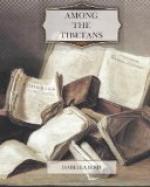CHAPTER V—CLIMATE AND NATURAL FEATURES
The last chapter left me with the chief and elders of the Chang-pas starting on ‘a round of visits,’ and it was not till nightfall that the solemn ceremony was concluded. Each of the fifty tents was visited: at every one a huge, savage Tibetan mastiff made an attempt to fly at me, and was pounced upon and held down by a woman little bigger than himself, and in each cheese and milk were offered and refused. In all I received a hearty welcome for the sake of the ‘great father,’ Mr. Redslob, who designated these people as ’the simplest and kindliest people on earth.’
This Chang-pa tribe, numbering five hundred souls, makes four moves in the year, dividing in summer, and uniting in a valley very free from snow in the winter. They are an exclusively pastoral people, and possess large herds of yaks and ponies and immense flocks of sheep and goats, the latter almost entirely the beautiful ’shawl goat,’ from the undergrowth at the base of the long hair of which the fine Kashmir shawls are made. This pashm is a provision which Nature makes against the intense cold of these altitudes, and grows on yaks, sheep, and dogs, as well as on most of the wild animals. The sheep is the big, hornless, flop-eared huniya. The yaks and sheep are the load carriers of Rupchu. Small or easily divided merchandise is carried by sheep, and bulkier goods by yaks, and the Chang-pas make a great deal of money by carrying for the Lahul, Central Ladak, and Rudok merchants, their sheep travelling as far as Gar in Chinese Tibet. They are paid in grain as well as coin, their own country producing no farinaceous food. They have only two uses for silver money. With part of their gains they pay the tribute to Kashmir, and they melt the rest, and work it into rude personal ornaments. According to an old arrangement between Lhassa and Leh, they carry brick tea free for the Lhassa merchants. They are Buddhists, and practise polyandry, but their young men do not become lamas, and owing to the scarcity of fuel, instead of burning their dead, they expose them with religious rites face upwards in desolate places, to be made away with by the birds of the air. All their tents have a god-shelf, on which are placed small images and sacred emblems. They dress as the Ladakis, except that the men wear shoes with very high turned-up points, and that the women, in addition to the perak, the usual ornament, place on the top of the head a large silver coronet with three tassels. In physiognomy they resemble the Ladakis, but the Mongolian type is purer, the eyes are more oblique, and the eyelids have a greater droop, the chins project more, and the mouths are handsomer. Many of the men, including the headman, were quite good-looking, but the upper lips of the women were apt to be ’tucked up,’ displaying very square teeth, as we have shown in the preceding chapter.




